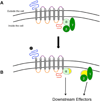Alternative Splicing of G Protein-Coupled Receptors: Relevance to Pain Management
- PMID: 26250730
- PMCID: PMC5024555
- DOI: 10.1016/j.mayocp.2015.06.010
Alternative Splicing of G Protein-Coupled Receptors: Relevance to Pain Management
Abstract
Drugs that target G protein-coupled receptors (GPCRs) represent the primary treatment strategy for patients with acute and chronic pain; however, there is substantial individual variability in both the efficacy and adverse effects associated with these drugs. Variability in drug responses is due, in part, to individuals' diversity in alternative splicing of pain-relevant GPCRs. G protein-coupled receptor alternative splice variants often exhibit distinct tissue distribution patterns, drug-binding properties, and signaling characteristics that may impact disease pathology as well as the extent and direction of analgesic effects. We review the importance of GPCRs and their known splice variants to the management of pain.
Copyright © 2015 Mayo Foundation for Medical Education and Research. Published by Elsevier Inc. All rights reserved.
Figures



Similar articles
-
A combined approach for the classification of G protein-coupled receptors and its application to detect GPCR splice variants.Comput Biol Chem. 2007 Aug;31(4):246-56. doi: 10.1016/j.compbiolchem.2007.05.002. Epub 2007 May 22. Comput Biol Chem. 2007. PMID: 17631418
-
Alternative mRNA splicing of G protein-coupled receptors.Methods Enzymol. 2013;520:323-35. doi: 10.1016/B978-0-12-391861-1.00015-0. Methods Enzymol. 2013. PMID: 23332707
-
Novel G protein-coupled receptors as pain targets.Curr Opin Investig Drugs. 2004 Jan;5(1):67-70. Curr Opin Investig Drugs. 2004. PMID: 14983976 Review.
-
Alternative splicing of the G protein-coupled receptor superfamily in human airway smooth muscle diversifies the complement of receptors.Proc Natl Acad Sci U S A. 2008 Apr 1;105(13):5230-5. doi: 10.1073/pnas.0801319105. Epub 2008 Mar 24. Proc Natl Acad Sci U S A. 2008. PMID: 18362331 Free PMC article.
-
Splice variants of G protein-coupled receptors.Mol Interv. 2001 Jun;1(2):108-16. Mol Interv. 2001. PMID: 14993330 Review.
Cited by
-
Gi-protein-coupled 5-HT1B/D receptor agonist sumatriptan induces type I hyperalgesic priming.Pain. 2016 Aug;157(8):1773-1782. doi: 10.1097/j.pain.0000000000000581. Pain. 2016. PMID: 27075428 Free PMC article.
-
PAC1, VPAC1, and VPAC2 Receptor Expression in Rat and Human Trigeminal Ganglia: Characterization of PACAP-Responsive Receptor Antibodies.Int J Mol Sci. 2022 Nov 9;23(22):13797. doi: 10.3390/ijms232213797. Int J Mol Sci. 2022. PMID: 36430275 Free PMC article.
-
Activation of locus coeruleus-spinal cord noradrenergic neurons alleviates neuropathic pain in mice via reducing neuroinflammation from astrocytes and microglia in spinal dorsal horn.J Neuroinflammation. 2022 May 27;19(1):123. doi: 10.1186/s12974-022-02489-9. J Neuroinflammation. 2022. PMID: 35624514 Free PMC article.
-
Detection of genome-edited and endogenously expressed G protein-coupled receptors.FEBS J. 2021 Apr;288(8):2585-2601. doi: 10.1111/febs.15729. Epub 2021 Feb 9. FEBS J. 2021. PMID: 33506623 Free PMC article. Review.
-
Genetic dissociation of morphine analgesia from hyperalgesia in mice.Psychopharmacology (Berl). 2017 Jun;234(12):1891-1900. doi: 10.1007/s00213-017-4600-2. Epub 2017 Mar 25. Psychopharmacology (Berl). 2017. PMID: 28343361 Free PMC article.
References
-
- Woolf CJ. American College of Physicians, American Physiological Society. Pain: moving from symptom control toward mechanism-specific pharmacologic management. Ann Intern Med. 2004;140(6):441–451. - PubMed
-
- Alan North R. Opioid receptor types and membrane ion channels. Trends Neurosci. 1986;9:114–117.
-
- Matsuda LA. Molecular aspects of cannabinoid receptors. Crit Rev Neurobiol. 1997;11(2–3):143–166. - PubMed
Publication types
MeSH terms
Substances
Grants and funding
LinkOut - more resources
Full Text Sources
Other Literature Sources
Medical

